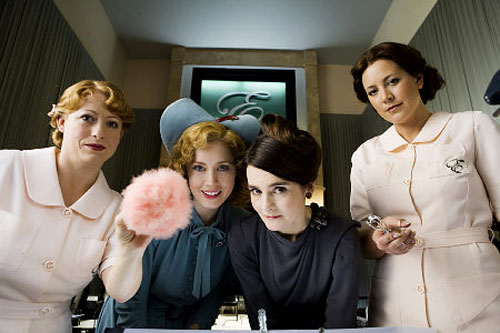|
In times of overriding national emergency, such as World War II, it is understood that a soldier who enlists or is drafted for that fight will serve for the duration. In more localized conflicts, such as the war in Vietnam, the military has always depended on the draft to obtain enough soldiers, generally allowing front-line personnel to rotate home after a set tour of duty.
So what happens when a localized conflict is being fought, and there is no draft? The current war in Iraq is giving the U.S. military a laboratory to experiment with that situation, and what it is doing is to exercise its prerogative of “stop-loss.” Stop-loss—a term that did not come into common currency before Iraq—allows the armed forces to extend soldiers’ tours of duty indefinitely, without their prior knowledge or consent.
The necessity and morality of the “stop-loss” policy could be debated endlessly. Kimberly Peirce, writer-director of the new film Stop-Loss, does not engage in that debate. Instead she shows us the effect of that policy on one soldier who has already served two frontline tours in Iraq, and who—expecting to retire to civilian life at home in Texas—is completely blindsided by orders to return to the front immediately.
The beginning of the film shows us the hell Sgt. Brandon King (Ryan Phillippe) has already been through. “Hell” is not hyperbolic: the first few minutes depict Brandon and his squad ambushed at a checkpoint and in a Baghdad apartment complex, leaving two soldiers dead and one hideously maimed. (As filmed by the great cinematographer Chris Menges, the entire opening sequence comes across as a grotesque parody of U.S. Army recruiting commercials.) Returning to Texas with a Bronze Star and a Purple Heart, Brandon already is starting to disengage from the Army: asked unexpectedly to give a speech, he rambles on about onions reminding him of home, and it’s up to his buddy Steve Shriver (Channing Tatum) to give the crowd the gung-ho platitudes it expects.
Peirce has already made the point that Brandon has spent far too much time in life-or-death situations that force him to make aggressive snap decisions, and that don’t reward patient, logical thought. When, going to muster out, he gets orders to go back to Iraq instead, he reacts predictably, at least in the context of the movie: he goes ballistic, insults his commanding officer, overpowers the MPs who try to arrest him, and runs.
 |
From that point, Brandon is alone. Peirce takes every conceivable opportunity to emphasize that Brandon is no draft-dodger (there being, of course, no draft to dodge), but a courageous, patriotic fighting man driven into an untenable position by a military hierarchy that sees him less as a man than as war materiel to be deployed at its pleasure. Because he is an enlisted man, he has no legal recourse: “stop-loss” is part of his contract with the Army. He has three choices: go back to Iraq, go to military prison, or leave America for good. Because there is no draft, there is no general public outcry about the plight of soldiers facing his dilemma. There is no structure to help people in his situation, only a very loose underground of soldiers fleeing court-martial and a shady lawyer (Peter Gerety) who gives stop-lossed soldiers new identities and forged Canadian passports for a price. The mealy-mouthed senator (Josef Sommer) who promised his help to Brandon the decorated war hero wants nothing to do with Brandon the AWOL soldier. Brandon’s rancher parents (Ciaran Hinds, Linda Emond) don’t want their son to go back to Iraq, but also don’t want him to disappear north or south of the border forever. Steve—whose own post-combat freakouts make Brandon’s look mild by comparison--sees Brandon as a traitor, pure and simple. Only Michelle (Abbie Cornish), Steve’s fed-up girlfriend, remains loyal, going on the lam with Brandon and offering him whatever help she can. (Michelle and Brandon’s friendship, believably in the film’s context, remains strictly that.)
Paul Haggis, in his anti-Iraq-war film In the Valley of Elah, argued that the Iraq conflict is proving uniquely debilitating to frontline soldiers, breaking down old patterns of comradeship and pride in service as well as simple human decency. Peirce makes no such argument in Stop-Loss; herself the sister of an Iraq veteran, she argues simply on behalf of American soldiers who have made enormous sacrifices for their country and don’t deserve to be forced to repeat them endlessly. The notes at the end of the film tell it all: of 650,000 U.S. soldiers sent to Iraq, 81,000 have been stop-lossed, as well as an unknown number of the 30,000 soldiers sent to Iraq during last year’s “surge.”
Stop-Loss contains many scenes of enormous power, as Brandon, Steve and their buddies try but mostly fail to reconnect with the simple pleasures of home. Peirce gets a lot of help from her actors: Phillippe, trapped in a morass of bewilderment and rage, gives his best performance to date, and Tatum and Cornish are fully his equals.
Peirce’s anger on their behalf burns through the celluloid; unfortunately, that anger also serves to make the movie somewhat misshapen. Its sorrowful ending, though inevitable, seems rushed and perfunctory after all that has gone before; also, all the characters except for Brandon, Steve and Michelle get short shrift on screen. Particularly, I wish Peirce had made Brandon’s commanding officer (Timothy Olyphant) less of a one-note martinet villain in his brief appearance; while her advocacy is for enlisted men and women, making Brandon’s commander a little more human would have helped her cause.
Two actors with smaller roles manage to make strong impressions. The always reliable Joseph Gordon-Levitt has some superb moments as Tommy, Brandon and Steve’s hometown buddy and fellow platoon member. Tommy, an alcoholic, is caught in a vicious downward spiral; he can’t imagine a life for himself outside the Army, yet his drunken rages make it less and less likely that the Army will keep him on. His inconsolable grief over the combat death of his best friend makes his plight exponentially worse. Victor Rasuk is equally powerful as Rico, the maimed member of Brandon’s squad, whom Brandon visits in a VA hospital. A double amputee, blinded and scarred, Rico has the sort of open, courageous spirit that no nation can do without—unless, as in the current war, it decides to cast it on the scrap heap.
I saw Bharat Nalluri’s Miss Pettigrew Lives for a Day just before seeing Stop-Loss, which is akin to drinking a champagne cocktail before getting napalmed.
In setting, style and tone, the two films could not be more different. Thematically, however, they have more in common than a cursory glance reveals.
Set in London in late August 1939, the screenplay by David Magee and Simon Purefoy begins with Miss Guinevere Pettigrew (Frances McDormand) getting sacked from her umpteenth job as a governess, leaving her broke and starving on the street. Through a forgivable bit of con artistry, Miss Pettigrew wangles her way into what she thinks is a position as governess with American singer-starlet Delysia Lafosse (Amy Adams).
Her first act is to try and waken Delysia’s naughty little boy Phil (Tom Payne), who turns out to be twenty-something, nursing a hangover, and naked except for his socks. It transpires that the childless Delysia expects Miss Pettigrew to be her “social secretary,” whose main duty is to make sure that Delysia’s various lovers don’t enter her bedroom simultaneously.
During the next twenty-four hours, Miss Pettigrew gets a whirlwind tour of Delysia’s glittering world (including a full makeover, 1930s style). She meets Delysia’s other lovers: the aptly named Nick Coldarelli (Mark Strong), sinister owner of the nightclub where Delysia sings, and Michael (Lee Pace), the impecunious, just-out-of-jail pianist whom Delysia really loves but who has no power to advance her career. Miss Pettigrew meets Joe Blumfield (Ciaran Hinds, as far from his Stop-Loss role as he can possibly get), a sexy and likable fashion designer to whom she is immediately drawn, and is reacquainted with catty Edythe Dubarry (Shirley Henderson), whom she met, briefly and unpleasantly, the previous evening. Without giving away plot points, Edythe has her own reasons for making things still more unpleasant for Miss Pettigrew.
 |
On the surface, Miss Pettigrew Lives for a Day is a beautifully designed soap bubble. The expertly performed, airily farcical doings are done up in eye-popping Art Deco style by production designer Sarah Greenwood and costume designer Michael O’Connor, and photographed glowingly by John de Borman. It is only about halfway into the film that a certain amount of steel starts showing through the fluff. The key is in the film’s time frame; newspaper headlines trumpet the imminence of what will eventually be known as World War II, and airplanes already are starting to fly in formation over London. Again without giving away too much, Miss Pettigrew remembers the first Great War all too well. There is a great moment in the film, during a party Delysia throws at her flat, in which Miss Pettigrew surveys the trivial-minded, high-society crowd chatting about their silly plans for the future, while England is poised to explode in flames. The look on Miss Pettigrew’s face speaks not only volumes, but libraries, and among other things it reconfirms the greatness of Frances McDormand. The mood of that scene is reinforced a little later on, in a scene at Nick’s nightclub, when Michael overrides Delysia’s choice of an opening number and forces her to sing, “If I Didn’t Care.” In the hands of Amy Adams--like McDormand an expert in finding the poignancy in comedy—the scene is ineffably moving. What begins as a door-slamming farce ends as a touching paean to the philosophy of Carpe Diem and to finding true happiness while you can.
Miss Pettigrew Lives for a Day is a charming comedy about the possibility of turning your life around in one day, a common enough theme for film comedy. It gains power, however, through the figure of Miss Pettigrew, a hangdog misfit as a domestic but a high-flyer in high society, who for more than twenty years followed a life path for which she was totally unsuited. It was a war, the film suggests just firmly enough, that forced her into that path. Could it be, perhaps, that this middle-aged London governess from 1939 has something basic and compelling in common with a young Army sergeant from Texas living nearly seven decades later? You be the judge.
|
